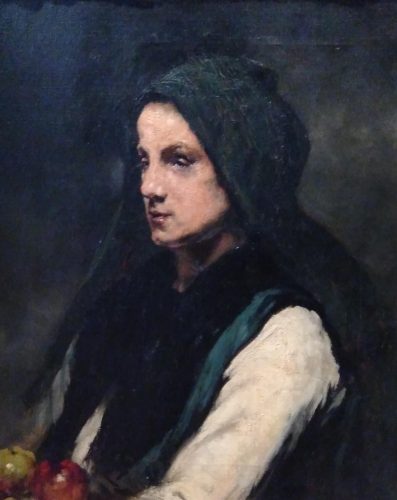The exhibition Théodule Ribot (1823-1891), a delicious darkness is to be discovered until October 2, at the Museum of Fine Arts in Caen. It required significant research and collaboration over nearly five years between the directors-curators of the Fine Arts Museums of Toulouse, Marseille and Caen.
A first retrospective took place in 2019, at the initiative of the Museums of Courbevoie and Colombes, the city where the painter died.
Ribot immediately catches the eye with his still lifes and his interest in small people. The sober and expressive works invite you to discover a talented artist who has treated different themes with a humanist look.
“Self-portrait” – Théodule Ribot, Museum of Art and History, Colombes © Fatma Alilate
–
A freelance painter
Singular, out of the mainstream, Ribot had an honest and independent personality. In fragile health, the painter experienced a difficult life and money worries – this concern appears in many canvases whose characters have pieces. He transmitted his art to his son Germain-Théodore Ribot (1845-1893) and to his daughter Louise Ribot (1857-1916) whom he represented at different ages. Essentially self-taught, Ribot was part of a learning dynamic that did not lock itself into any theme. An admirer of the old masters, particularly from the Spanish Golden Age, he also admired Courbet, Millet, Corot and had as friends eminent artists such as Théophile Gautier, Boudin, Fantin-Latour. Critics were mixed, he was criticized for his too black tones. The painter did not hesitate to show the dirty, the poverty, faces ravaged by existence.
The exhibition at the Musée des Beaux-Arts in Caen offers a coherent scenography with nearly ninety paintings from French and international collections. A whole section of wall recreates the modest, dimly lit attic studio where Ribot painted, in Colombes. His painting gives an impression of proximity.

“A Leg”- Théodule Ribot, Museum of Picardy, Amiens © Fatma Alilate
–
Innovative still lifes
Still life is at the heart of his work. There is simplicity, economy of means and spectacularity. Ribot chooses unexpected motifs such as eggs by skilfully playing on solids and voids and even a sheep’s skull. A leg, with the black eye effect in the meat, was avant-garde long before Soutine. On a black background, the renderings of matter seem to envelop each object or victual. For Ribot, still life is “the most instructive, the most profitable, the safest preparatory exercise in the study of the portrait or the nude”.
At his first Salon in 1861, Ribot enjoyed success for his paintings of cooks which coincided with the rise of restaurants and gastronomy. On this theme, he is a pioneer with Bonvin. It will inspire Joseph Bail (1862-1921) whose canvas Marmiton wearing mulletsradiant with youth and audacity, eclipses the other paintings of the same theme.
The portraits and genre scenes reflect a strong interest in the human. The characters are absorbed in their thoughts. The highly worked hands call for movement and “give spirit to heads.” Ribot also tries his hand at the figure of fantasy, notably through a series devoted to musicians – he illustrated scores at the start of his career.
In the 1860s, he produced religious compositions, large tortured nudes. It also deals with the subject of fables and thinkers. History painting remains radical, his talent remarkable.

“The Good Samaritan” – Théodule Ribot, Musée d’Orsay, Paris © Fatma Alilate
–
A scrutinizer of the soul, Ribot offers an interiority through rich impastos and skilful contrasts. The games of shadow and light animate the texture, the design of the wrinkles, the intensity of the gaze. He revisits admired works, following his own path backwards from his time.
This large-scale exhibition around an unknown painter is a courageous choice that brings progress. It is an encounter with a great painter with a humble and endearing personality.
Fatma Alilate
Catalogue Théodule Ribot (1823-1891), a delicious darkness by Emmanuelle Delapierre, Luc Georget, Axel Hémery, Dominique Lobstein, Louise Sangla, Dr. Gabriel P. Weisberg; 256 color pages, Liénart edition, €30.
–

![War in Ukraine. Latest information on June 16 [papildināts 07:09] War in Ukraine. Latest information on June 16 [papildināts 07:09]](https://zinas.nra.lv/_mm/photos/2022-06/860px/568158_88f8245e9d.jpg)
